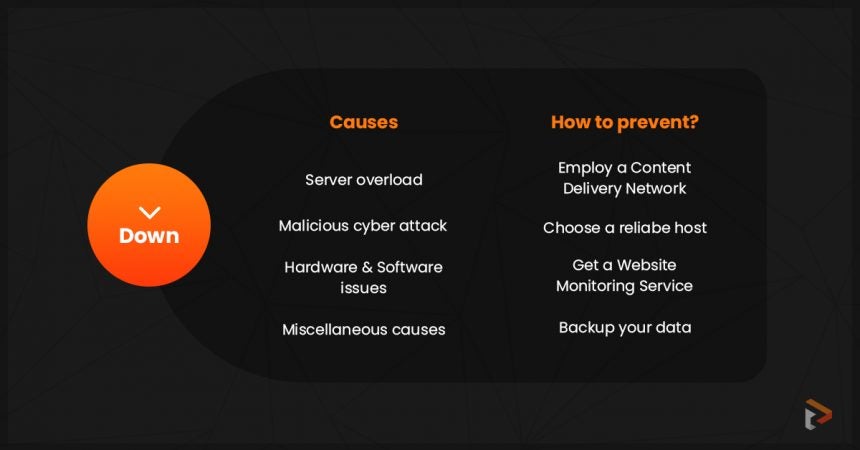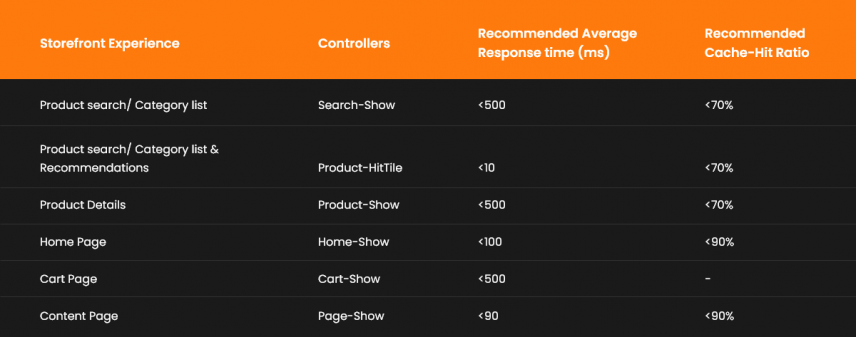- Sweep out old data: Remove your old data, including that of campaigns, catalogs, promotions, content., coupons, wish lists, content assets, and more to improve website performance standards and load speed. You can keep inventory records, product prices and lists, and redeemed coupons data.
- Caching rules: You can cache pages like home pages or search pages, but do not cache pages that have dynamic data or include customer-specific content.
- Check for code error: Evaluate all code discrepancies in pipeline and script runtimes. Monitor all the external services that might hurt your site’s performance.
Practice #3: Put all your resources to the test
When projecting this year’s peak holiday season traffic, load test your digital retail websites to evaluate how your site might hold up against the expected incoming traffic. You surely don’t want to lose eCommerce sales and customers due to website downtime. Remember, regular testing of your site will be the unsung hero of your global peak retail site performance during this holiday season. So, test deficiencies, document failure points, and explore ways to address these points. Here are a few factors affecting your website performance and metrics that you need to test.
- Loading speed: Test your site and that of your competitors to see how it holds under peak visits, product searches, orders placed, and checkout directed all the way to payment pages. Remember, every customer wants a speedy and seamless eCommerce site experience right from the time they land on your site till they place their orders and pay for it.
- Incoming traffic: Check your site for incoming traffic management. Also consider how this traffic should flow through your site.
- Test its performance: If you’ve partnered with a reputed eCommerce service provider, then it is their job to perform regular website speed testing to test for any issues. There are several options when it comes to monitoring site performance. So, pick a method that pairs well with your eCommerce site. Adobe Commerce’s New Relic Nerdlet allows a snapshot of overall site performances as well as added information about potential performance issues.
Practice #4: Work towards improving your eCommerce site experiences
Several things go into maintaining the website performance standards of your eCommerce site. All of these practices ensure peak-season performance with no website downtime and high loading speed. The following are some how to improve website performance tips to boost conversion numbers:
Optimize images for fast eCommerce experience:
Images play a pivotal role in a consumer’s buying decision, impacting eCommerce sales. But when not optimized and poorly managed, it negatively impacts website performance standards and page load time. So, resize and optimize product images.
Back up your eCommerce site data:
Anything can go wrong during the deployment process. Therefore, you must employ proper back-up processes to prevent a tedious rollout. So, backup data so that you can restore specific environments at any time, saving critical time and money.
Keep in touch with your eCommerce provider’s team:
- As a solutions partner to several iconic brands, we tend to discuss the support plans for the eCommerce holiday season beforehand so that everyone can execute the plan on time and handle all throttles should anything unexpected happen.
- We put together a team of leaders from IT, support, operations, customer and brand departments and plan the escalation procedure.
- Our experts provide a step-by-step plan to alert the right people in case of issues, handle all technical and security issues as and when they occur, and ensure speedy performance at all times.
- We plan a 24/7 support procedure for planned holiday periods and even the unplanned ones. We keep our clients in loop as well.
Don’t let deployment hamper your eCommerce sales:
It is important that your visitors browse and shop uninterrupted during the peak eCommerce website traffic season, which is why you might need to push immediate changes to the production environment to ensure speedy site performance. Adobe Commerce allows retailers to configure their project in a way so that their customers easily engage with a live site and experience zero website downtime during deployment routines.
Practice #5: Protect your site and customer data
In today’s data-driven economy, customer information is a goldmine for brands. Since this data is worth billions of dollars to brands, it is more likely to be stolen or hacked. It is why you need to protect your site’s information, including critical consumer data. Follow these steps to ensure a safe and secure browsing experience during this peak holiday season.
Upgrade to the latest versions of your eCommerce platforms:
As data stealing has become a more serious threat than ever, it is imperative that merchants update their retail websites software to the latest versions before heading into the peak holiday season. Hackers use flash sales as a way to pull up the biggest frauds and steal precious consumer data. So, if you haven’t upgraded your site yet, do so before the holiday season.
Use in-built security tools:
Modern eCommerce platforms tend to have a security system in place to prevent hackers from entering your software.
- For example, Adobe Commerce merchants can employ the Security Scan tool to run over 21,000 tests on their sites, receive insights about security risks in real-time, and improve the digital security of the storefront. Moreover, retailers can even schedule security checks daily or weekly. The idea is to resolve all the issues mentioned in the security scan to ensure peak performance.
- On the contrary, Salesforce Commerce Cloud requires a two-factor authentication to gain entry into the platform to prevent security attacks, phishing, form-jacking (hackers inserting malicious code to your site to steal customer data), card-skimming and other cyber attacks.
Perform security patches:
Security patches are a way to keep pace with the latest security trends. It is recommended to install security patches as and when they’re available before they stack up. It will help you optimize your regular eCommerce website performance standards as well.
Keep up with the privacy regulations:
Ensure that your eCommerce site is up-to-date on the privacy regulations required as mandated by a region or a country. As a part of our digital commerce maintenance and support services, we help our clients stay navigate all regulations and ensure they are compliant with all the relevant practices.
Ready to make the most of the holiday season eCommerce sales?
Readying your eCommerce site for the peak holiday season is a work in progress. You cannot expect peak performance and zero website downtime without moving a stone. However, with the right way to improve website performance tips and tactics, you can surely make a fortune out of this holiday season.
Regardless of which eCommerce platform you’re on, if you’ve partnered with a Solutions Partner like Ranosys, then you don’t have to worry about website performance standards and scalability. Our experts offer hands-on support during every phase of your eCommerce growth journey. We ensure that our clients receive all the support they need, from resources to expert advice, which is why we offer continuous 24/7 eCommerce support services. With us by your side, you can confidently handle all sudden surges in your retail website traffic.







